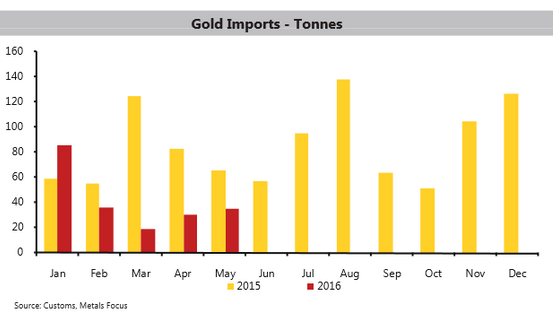
India’s gold prices reducing gold demand whilst government schemes struggle…
HIGH GOLD PRICES have seen India’s gold import volume fall sharply, something the government has been trying to achieve with new schemes to deter household demand since the end of 2015, writes Katie Hillan at BullionVault.
With gold prices in Rupee terms rising over 16% in 2016 so far, gold imports into India have fallen year-on-year for four months straight due as consumers cut their demand.
“At this level,” says trade body director Bachhraj Bamalwa at the All India Gems and Jewellery Trade Federation, “no one wants to buy. Everyone is waiting for a correction.”
April saw only 22 tonnes imported, with May’s inflow to the world’s No.2 consumer market more than halving from the same month last year to 31 tonnes.
2015 imports totalled 939 tonnes – a monthly average above 78 – despite the launch of several government schemes aimed at deterring demand.
With Indian residents owning an estimated total 11% of the global gold stock, the Indian government last year announced two schemes to try and curb India’s high demand for gold.
The objective of the Gold Monetisation Scheme (GMS) was to mobilise some of the gold already held by Indian households, estimated to be around 22,000 tonnes worth $1 trillion.
The scheme then plans to make gold available as a raw material, on loan, to the jewellery sector in order to reduce its reliance on imported bullion to meet new domestic demand.
Over the past 6 months only 2.8 tonnes of gold have been collected under the GMS.
State-owned Punjab National Bank is the top gold collector, having mobilised 1,311kg of gold, according to The Economic Times of India.
The Sovereign Gold Bond Scheme, meanwhile, allows investors to acquire returns linked to the gold price, plus a rate of interest. The bonds are bought and sold in Rupees but denominated in grams of gold.
The first three tranches of gold bonds, issued between November and March, attracted Rupee investment equal to 3.8 tonnes according to figures quoted by India Express.
“Prices [are] expected to move higher during the second half of this year,” says specialist consultancy Metals Focus in its latest India Focus Monthly.
“As price expectations continue to improve, this will lure back Indian investors and see consumers increase their spend on gold.”
Gold importing increased in May from March and April’s lows, when many Indian jewellers were closed in protest at the government imposing a new 1% excise tax in its February budget on all gold objects made and sold in India.
“The excise duty will bring jewellers’ business to a standstill,” said Ketan Shroff, a spokesman for India Bullion and Jewellers Association, warning that many of the nearly 10 million artisans working in the industry could lose their jobs.
full article: Gold Price Cuts India Demand as Government Schemes Don’t
Disclaimer © 2010 Junior Gold Report
Junior Gold Report’ Newsletter: Junior Gold Report’s Newsletter is published as a copyright publication of Junior Gold Report (JGR). No Guarantee as to Content: Although JGR attempts to research thoroughly and present information based on sources we believe to be reliable, there are no guarantees as to the accuracy or completeness of the information contained herein. Any statements expressed are subject to change without notice. JGR, its associates, authors, and affiliates are not responsible for errors or omissions.
Forward Looking Statements
Except for statements of historical fact, certain information contained herein constitutes forward-looking statements. Forward looking statements are usually identified by our use of certain terminology, including “will”, “believes”, “may”, “expects”, “should”, “seeks”, “anticipates”, “has potential to”, or “intends’ or by discussions of strategy, forward looking numbers or intentions. Such forward-looking statements involve known and unknown risks, uncertainties and other factors which may cause our actual results or achievements to be materially different from any future results or achievements expressed or implied by such forward-looking statements. Forward-looking statements are statements that are not historical facts, and include but are not limited to, estimates and their underlying assumptions; statements regarding plans, objectives and expectations with respect to the effectiveness of the Company’s business model; future operations, products and services; the impact of regulatory initiatives on the Company’s operations; the size of and opportunities related to the market for the Company’s products; general industry and macroeconomic growth rates; expectations related to possible joint and/or strategic ventures and statements regarding future performance. Junior Gold Report does not take responsibility for accuracy of forward looking statements and advises the reader to perform own due diligence on forward looking numbers or statements.


